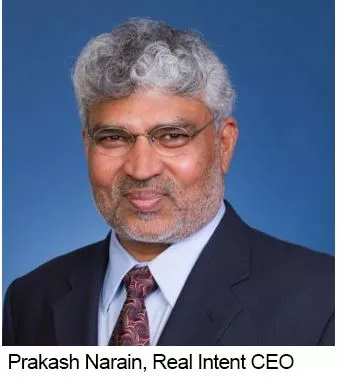
Prakash Narain, a founder of Real Intent who serves as its president and CEO, grew his skillset from EDA tool developer to senior executive. In our recent conversation, he describes how his thirst to build a company led to the founding of Real Intent 25 years ago. He also offers advice on how to move into management or entrepreneurism and we conclude our talk with his opinion of recent industry trends.
Smith: How did your career journey get you into the business world and on to becoming the leader of Real Intent?
Narain: My background is in engineering; I received my Ph.D. from the University of Illinois at Champaign-Urbana. I first worked in EDA tool development at IBM EDA, CAD flow development at AMD, then moved on to semiconductor design at Sun Microsystems.
I always had a thirst to build a company to solve problems and improve the status quo. Over time, I decided it was important to address the verification challenges that our industry faced. That led to the founding of Real Intent 25 years ago, back in 1998.
Initially our target technology was in formal verification; however, we were way ahead of our time, as there was not even an assertion standard available.
 We successfully worked through the System-Verilog standardization process – yet in the end, we recognized that there was a bigger need for a higher capacity, higher performance verification solution. So, we pivoted and invented an approach that we term functional static sign-off.
We successfully worked through the System-Verilog standardization process – yet in the end, we recognized that there was a bigger need for a higher capacity, higher performance verification solution. So, we pivoted and invented an approach that we term functional static sign-off.
My background when we first founded Real Intent was all based in engineering and I didn’t have much management experience. Building a successful company requires a more diverse set of skills. I had to develop these along the way by learning how to manage people and products, as well as administration, business management, marketing, and sales.
Real Intent is profitable and doing very well today. We have a strong, expanding product portfolio, a collaborative organization, and an engaged customer base.
Smith: How do you perceive leadership?
Narain: Leadership to me is about how you get things done – how you facilitate change. Significant achievements require a group effort. As a leader, you must motivate people and create an environment where large groups of people can work cooperatively and excel.
That environment needs to be weaved together in a way that enables everyone to grow within their domain of competency, so that as a group the team can accomplish something significant.
 There are leaders who may look to control and leave their imprint on everything. However, when you hire very good people and want them to make significant contributions, you must be able to delegate to them – and accept that you will have near-term dependencies on them.
There are leaders who may look to control and leave their imprint on everything. However, when you hire very good people and want them to make significant contributions, you must be able to delegate to them – and accept that you will have near-term dependencies on them.
This leadership style of empowering people has worked very well for me. Leadership and entrepreneurship require creativity to imagine new ways to create value for a product and its applications, as well as in setting goals and communicating in a way that inspires people.
Smith: How has your engineering background helped inform your leadership style?
Narain: Electronic design automation is a very engineering heavy industry. Having the relevant engineering domain knowledge and expertise is essential to operating as a leader in comprehending the technology challenges you face and making the right judgment calls.
This engineering domain expertise also allows you to effectively communicate with the people you lead as well as promote the value of your company and its products to your customers and the industry.
Smith: What advice would you give to someone wanting to grow into a management role or to budding entrepreneurs?
Narain: My advice to engineers wanting to transition to become budding entrepreneurs is: Do not take entrepreneurship lightly – it's hard. Be aware that it requires a lot of personal grit to come out on the other side to run a successful, profitable company.
 For engineers wanting to grow into a management role, I would simplify management into three dimensions – people managers, process managers, and engineering managers.
For engineers wanting to grow into a management role, I would simplify management into three dimensions – people managers, process managers, and engineering managers.
Everyone will have a different balance of these three attributes, and my advice would be to know your own strengths and work to develop your management style in all three dimensions.
Smith: What’s on your mind these days? What trends are you seeing?
Narain: Across the tech industry, we see this massive trend toward the development and deployment of artificial intelligence and machine learning. The important question is – can we leverage AI techniques to advance the engineering domains in which we operate.
At Real intent, we are focused on enabling shift left with static sign-off. I also see tremendous opportunity in the static sign-off domain to continue to advance and expand through new applications for enabling shift left in verification for various design flow aspects. Shift left can be defined as the earliest possible efficient verification of a design step.
About Prakash Narain
Dr. Prakash Narain is President and CEO of Real Intent. His career spans IBM, AMD and Sun where he had hands on experience with all aspects of IC design, CAD tools design and methodology. He was the project leader for test and verification for UltraSPARC III at Sun Microsystems. He was an architect of the Mercury Design System at AMD. He has architected and developed CAD tools for test and verification for IBM EDA. Dr. Narain has a Ph.D. from the University of Illinois at Champaign-Urbana where his thesis focus was on algorithms for high level testing and verification.
Robert (Bob) Smith is executive director of the ESD Alliance, a SEMI Technology Community.